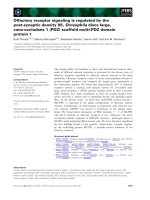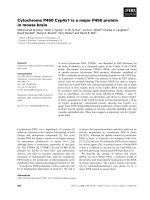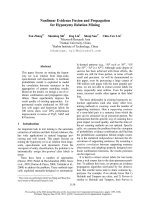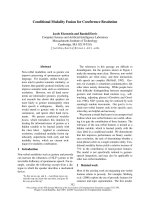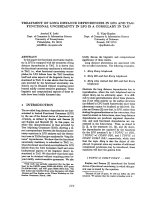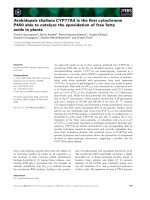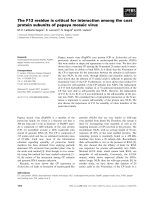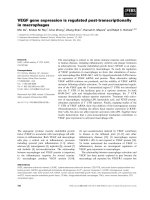Báo cáo khoa học: "Query-based sentence fusion is better defined and leads to more preferred results than generic sentence fusion∗" pdf
Bạn đang xem bản rút gọn của tài liệu. Xem và tải ngay bản đầy đủ của tài liệu tại đây (106.12 KB, 4 trang )
Proceedings of ACL-08: HLT, Short Papers (Companion Volume), pages 193–196,
Columbus, Ohio, USA, June 2008.
c
2008 Association for Computational Linguistics
Query-based sentence fusion is better defined and leads to
more preferred results than generic sentence fusion
∗
Emiel Krahmer
Tilburg University
Tilburg, The Netherlands
Erwin Marsi
Tilburg University
Tilburg, The Netherlands
Paul van Pelt
Tilburg University
Tilburg, The Netherlands
Abstract
We show that question-based sentence fu-
sion is a better defined task than generic sen-
tence fusion (Q-based fusions are shorter, dis-
play less variety in length, yield more identi-
cal results and have higher normalized Rouge
scores). Moreover, we show that in a QA set-
ting, participants strongly prefer Q-based fu-
sions over generic ones, and have a preference
for union over intersection fusions.
1 Introduction
Sentence fusion is a text-to-text generation applica-
tion, which given two related sentences, outputs a
single sentence expressing the information shared
by the two input sentences (Barzilay and McKeown
2005). Consider, for example, the following pair of
sentences:
1
(1) Posttraumatic stress disorder (PTSD) is a
psychological disorder which is classified as
an anxiety disorder in the DSM-IV.
(2) Posttraumatic stress disorder (abbrev.
PTSD) is a psychological disorder caused by
a mental trauma (also called psychotrauma)
that can develop after exposure to a terrifying
event.
∗
Thanks are due to Ed Hovy for discussions on the Rouge
metrics and to Carel van Wijk for statistical advice. The data-
set described in this paper (2200 fusions of pairs of sentences)
is available upon request. This research was carried out within
the Deaso project ( />1
All examples are English translations of Dutch originals.
Fusing these two sentences with the strategy de-
scribed by Barzilay and McKeown (based on align-
ing and fusing the respective dependency trees)
would result in a sentence like (3).
(3) Posttraumatic stress disorder (PTSD) is a
psychological disorder.
Barzilay and McKeown (2005) argue convincingly
that employing such a fusion strategy in a multi-
document summarization system can result in more
informative and more coherent summaries.
It should be noted, however, that there are multi-
ple ways to fuse two sentences. Besides fusing the
shared information present in both sentences, we can
conceivably also fuse them such that all information
present in either of the sentences is kept, without any
redundancies. Marsi and Krahmer (2005) refer to
this latter strategy as union fusion (as opposed to
intersection fusion, as in (3)). A possible union fu-
sion of (1) and (2) would be:
(4) Posttraumatic stress disorder (PTSD) is a
psychological disorder, which is classified
as an anxiety disorder in the DSM-IV,
caused by a mental trauma (also called psy-
chotrauma) that can develop after exposure
to a terrifying event.
Marsi and Krahmer (2005) propose an algorithm
which is capable of producing both fusion types.
Which type is more useful is likely to depend on
the kind of application and information needs of the
user, but this is essentially still an open question.
193
However, there is a complication. Daum
´
e III &
Marcu (2004) argue that generic sentence fusion is
an ill-defined task. They describe experimental data
showing that when participants are given two con-
secutive sentences from a single document and are
asked to fuse them (in the intersection sense), differ-
ent participants produce very different fusions. Nat-
urally, if human participants cannot reliably perform
fusions, evaluating automatic fusion strategies is al-
ways going to be a shaky business. The question
is why different participants come to different fu-
sions. One possibility, which we explore in this pa-
per, is that it is the generic nature of the fusion which
causes problems. In particular, we hypothesize that
fusing two sentences in the context of a preceding
question (the natural setting in QA applications) re-
sults in more agreement among humans. A related
question is of course what the results would be for
union fusion. Will people agree more on the unions
than on the intersections? And is the effect of a pre-
ceding question the same for both kinds of fusion?
In Experiment I, below, we address these questions,
by collecting and comparing four different fusions
for various pairs of related sentences, both generic
and question-based ones, and both intersection and
union ones.
While it seems a reasonable hypothesis that
question-based fusions will lead to more agreement
among humans, the really interesting question is
which fusion strategy (if any) is most appreciated
by users in a task-based evaluation. Given that Ex-
periment I gives us four different fusions per pair of
sentence, an interesting follow-up question is which
leads to the best answers in a QA setting. Do par-
ticipants prefer concise (intersection) or complete
(union) answers? And does it matter whether the
fusion was question-based or not? In Experiment
II, we address these questions via an evaluation
experiment using a (simulated) medical question-
answering system, in which participants have to rank
four answers (resulting from generic and question-
based intersection and union fusions) for different
medical questions.
2 Experiment I: Data-collection
Method To collect pairs of related sentences to be
fused under different conditions, we proceeded as
Fusion type Length M (SD) # Id.
Generic Intersection 15.6 (2.9) 73
Q-Based Intersection 8.1 (2.5) 189
Generic Union 31.2 (7.8) 109
Q-Based Union 19.2 (4.7) 134
Table 1: Mean sentence length (plus Standard Deviation)
and number of identical fusion results as a function of
fusion type (n = 550 for each type).
follows. As our starting point we used a set of
100 medical questions compiled as a benchmark for
evaluating medical QA systems, where all correct
answers were manually retrieved from the available
text material. Based on this set, we randomly se-
lected 25 questions for which more than one answer
could be found (otherwise there would be nothing
to fuse), and where the first two answer sentences
shared at least some information (otherwise inter-
section fusion would be impossible).
Participants were 44 native speakers of Dutch (20
women) with an average age of 30.1 years, none
with a background in sentence fusion research. Ex-
periment I has a mixed between-within subjects de-
sign. Participants were randomly assigned to either
the intersection or the union condition, and within
each condition they first had to produce 25 generic
and then 25 question-based fusions. In the latter
case, participants were given the original question
used to retrieve the sentences to be fused.
The experiment was run using a web-based
script. Participants were told that the purpose of the
experiment was merely to gather data, they were not
informed about our interest in generic vs question
based fusion. Before participants could start with
their task, the concept of sentence fusion (either
fusion or intersection, depending on the condition)
was explained, using a number of worked examples.
After this, the actual experiment started.
Results First consider the descriptive statistics in Ta-
ble 1. Naturally, intersection fusion leads to shorter
sentences on average than union fusion. More in-
terestingly, question (Q)-based fusions lead to sig-
nificantly shorter sentences than their generic coun-
terparts (intersection t = 9.1, p < .001, union:
t = 6.1, p < .001, two-tailed). Also note that
194
Generic Q-Based Generic Q-Based
Intersection Intersection Union Union
Rouge-1 .036 .068 .035 .041
Rouge-SU4 .014 .038 .018 .020
Rouge-SU9 .014 .040 .016 .020
Table 2: Average Rouge-1, Rouge-SU4 and Rouge-SU9 (normalized for sentence length) as a function of fusion type.
the variation among participants decreases in the Q-
based conditions (lower standard deviations). This
suggests that participants in the Q-based conditions
indeed show less variety in their fusions than partic-
ipants in the generic conditions. This is confirmed
by the number of identical (i.e., duplicated) fusions,
which is indeed higher in the Q-based conditions,
although the difference is only significant for inter-
sections (χ
2
(1) = 51.3, p < .001).
We also computed average Rouge-1, Rouge-SU4
and Rouge-SU9 scores for each set of fusions, to
be able to quantify the overlap between participants
in the various conditions. One complication is that
these metrics are sensitive to sentence-length (longer
sentences are more likely to contain overlapping
words than shorter ones), hence in Table 2 we report
on Rouge scores that are normalized with respect
sentence length. The resulting picture is surprisingly
consistent: Q-based fusion on all three metrics re-
sults in higher normalized Rouge scores, where the
difference is generally small in the case of union,
and rather substantial for intersection.
3 Experiment II: Evaluation
The previous experiment indicates that Q-based
fusion is indeed a better-defined summarization task
than generic fusion, in this experiment we address
the question which kind of fusion participants prefer
in a QA application.
Method We selected 20 from the 25 questions
used in Experiment I, for which we made sure
that the fusions in the four categories resulted
in sentences with a sufficiently different content.
For each question, one representative sentence
was selected from the 22 fusions produced by
participants in Experiment I, for each of the four
categories (Q-based intersection, Q-based union,
Generic intersection and Generic union). This
Fusion type Mean Rank
Q-Based Union 1.888
Q-Based Intersection 2.471
Generic Intersection 2.709
Generic Union 2.932
Table 4: Mean rank from 1 (= “best”) to 4 (=“worst”) as
a function of fusion type.
representative sentence was the most frequent result
for that particular category. When no such sentence
was present for a particular task, a random selection
was made.
Participants were 38 native speakers of Dutch (17
men), with an average age of 39.4 years. None
had participated in Experiment I and none had a
background in sentence fusion research. Participants
were confronted with the selected 20 questions, one
at a time. For each question, participants saw four
alternative answers (one from each category). Fig-
ure 3 shows one question, with four different fusions
derived by participants from example sentences (1)
and (2). Naturally, the labels for the 4 fusion strate-
gies were not part of the experiment. Participants
were asked to rank the 4 answers from “best” (rank
1) to “worst” (rank 4), via a forced choice paradigm
(i.e., they also had to make a choice if they felt that
two answers were roughly as good). Experiment II
had a within-subjects design, which means that all
38 participants ranked the answers for all 20 ques-
tions.
Results Table 4 gives the mean rank for the four
fusion types. To test for significance, we per-
formed a repeated measures Analysis of Variance
(ANOVA) with fusion type and question as the in-
dependent variables and average rank as the depen-
dent variable. A main effect was found of fusion
type (F (3, 111) = 20.938, p < .001, η
2
= .361).
195
What is PTSD?
Generic Intersection Posttraumatic stress disorder (PTSD) is a psychological disorder.
Q-based Intersection PTSD stands for posttraumatic stress disorder and is a psychological disorder.
Generic Union Posttraumatic stress disorder (PTSD) is a psychological disorder, which is classified as an
anxiety disorder in the DSM-IV, caused by a mental trauma (also called psychotrauma) that
can develop after exposure to a terrifying event.
Q-based Union PTSD (posttraumatic stress disorder) is a psychological disorder caused by a mental trauma
(also called psychotrauma) that can develop after exposure to a terrifying event.
Table 3: Example question from Experiment II, with four possible answers, based on different fusions strategies
(obtained in Experiment I).
Pairwise comparisons using the Bonferroni method
show that all comparisons are statistically significant
(at p < .001) except for the one between Generic In-
tersection and Generic Union. Thus, in particular:
Q-based union is ranked significantly higher than
Q-based intersection, which in turn is ranked sig-
nificantly higher than both Generic union and inter-
section (whose respective ranks are not significantly
different).
The ANOVA analysis also revealed a significant
interaction between question and type of fusion
(F (57, 2109) = 7.459, p < .001, η
2
= .168).
2
What this means is that relative ranking varies for
different questions. To better understand this inter-
action, we performed a series of Friedman tests for
each question (the Friedman test is a standard non-
parametric test for ranked data). The Friedman anal-
yses revealed that the overall pattern (Q-based union
> Q-based intersection > Generic Union / Intersec-
tion) was found to be significant for 13 out of the
20 questions. For four of the remaining seven ques-
tions, Q-based union ranked first as well, while for
two questions Q-based intersection was ranked as
the best answer. For the remaining question, there
was no significant difference between the four fu-
sion types.
4 Conclusion and discussion
In this paper we have addressed two questions. First:
is Q-based fusion a better defined task than generic
fusion? Here, the answer seems to be “yes”: Q-
based fusions are shorter, display less variety in
length, result in more identically fused sentences
2
Naturally, there can be no main effect of question, since
there is no variance; the ranks 1-4 are fixed for each question.
and have higher normalized Rouge scores, where the
differences are larger for intersection than for union.
Inspection of the fused sentences reveals that there
is simply more potential variation on the word level
(do I select this word from one input sentence or
from the other?) for union fusion than for inter-
section fusion. Second: which kind of fusion (if
any) do users of a medical QA system prefer? Here
a consistent preference order was found, with rank
1 = Q-based union, rank 2 = Q-based Intersection,
rank 3/4 = Generic intersection / union. Thus: par-
ticipants clearly prefer Q-based fusions, and prefer
more complete answers over shorter ones.
In future research, we intend to collect new data
with different questions per sentence pair, to find out
to what extent the question and its phrasing drive
the fusion process. In addition, we will also let sen-
tences from different domains be fused, based on the
hypothesis that fusion strategies may differ across
domains.
References
Regina Barzilay and Kathleen McKeown. 2005. Sen-
tence Fusion for Multidocument News Summariza-
tion. Computational Linguistics, 31(3), 297-328.
Hal Daum
´
e III and Daniel Marcu. 2004. Generic Sen-
tence Fusion is an Ill-Defined Summarization Task.
Proceedings of the ACL Text Summarization Branches
Out Workshop, Barcelona, Spain.
Chin-Yew Lin and Eduard Hovy. 2003. Automatic evalu-
ation of summaries using N-gram co-occurrence statis-
tics. Proceedings of NAACL ’03, Edmonton, Canada.
Erwin Marsi and Emiel Krahmer. 2005. Explorations
in Sentence Fusion. Proceedings of the 10th Euro-
pean Workshop on Natural Language Generation, Ab-
erdeen, UK.
196
